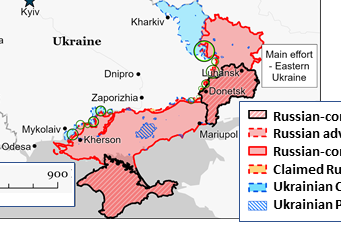
Ukraine War Territory
Since Russia’s invasion of Ukraine on 24 February 2022, there has been international focus on fighting along a very wide front in the south and east of Ukraine. Though Russia has essentially been in armed conflict with Ukraine since 2014, I focus on the fighting that started in February. Here is a summary of the big picture using maps of approximately the eastern 2/3 of the country from the Institute for the Study of War.

Territory occupied before 24 February is shown by red cross-hatching in all but the first map. Russia occupied the Crimean Peninsula in the South, and parts of the Donbas region in the southeast were occupied by forces of Russia and its allies. Russia annexed Crimea and declared the breakaway Donbas territories to be independent, but these claims have been rejected by the international community.
Almost all of Russia’s territorial gains came in the first month of the war (top left panel), mostly in the first week of fighting. By 2 months into the war (top middle panel), Russia gave up on its attempt to capture Kyiv and withdrew from northern territories. It also expanded its hold on the south and southeast, and completed the conquest of Mariupol. Until late summer, the boundary of Russian-occupied territory did not change much. However, there was intense fighting which resulted in concentrated destruction and high casualties for both sides. Ukraine regained some territory around Kharkiv (its second largest city), and Russia expanded its control over the Donbas; both changes are too small to easily see on the maps.
Between 24 August (bottom middle panel) and 26 September (bottom right), Ukraine made dramatic advances in the east, greatly expanding the region of liberated territory near Kharkiv. These advances were particularly embarrassing for Russia because in many places their forces fled in a rout, leaving equipment behind as they retreated. Ukraine also made smaller advances in the vicinity of Kherson.
Despite these Ukrainian victories, Russia still controls most of the territory that they seized between 24 February and 26 April – my guess is about 80%. Ukraine continues to make progress against Russian forces at the western edge of occupied territory, where the wide Dnipro River separates the Russians from the rest of the occupied territory and Ukrainian attacks have severed bridges across the river. While imminent Ukrainian liberation of the city of Kherson and other territory west of the Dnipro is plausible, it will still leave Russia in control of a large swathe of territory.
What do these geographical facts say about the future of the war? Ukrainian momentum in the war, the strong support of western allies that collectively have much stronger economies and militaries than Russia, and the giant morale gap between Ukrainians fighting for their homes and Russians fighting as an alternative to prison all point to the possibility of a massive Ukrainian win. After all, Russia took over most of the territories quickly, if there is a larger collapse of their military effort, they could lose them just as quickly.
But let’s not trivialize the task that Ukraine and its allies face. Ukraine has been fighting hard for months and at their best moments were able to liberate around 20% of the land they lost in the war. Even with resupply uncertain in Kherson, Russians there have put up a fierce fight in places. It is likely that Ukraine will have to endure great sacrifice to liberate the rest of the territory from Russia, which appears to continue to be determined to bring resources to the fight, even at the expense of internal political stability.
To me, this argues for continued acceleration of military support from the US and the rest of NATO. The faster Ukraine receives more hardware and training from us, the fewer Ukrainians will die in a protracted war.